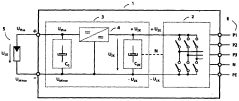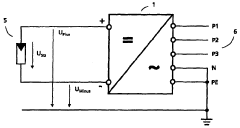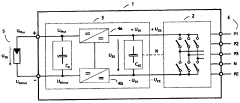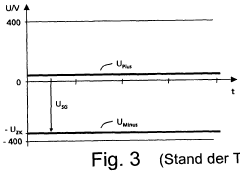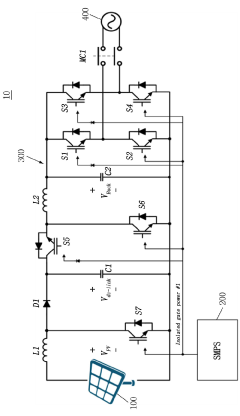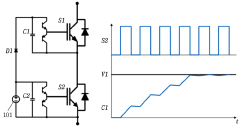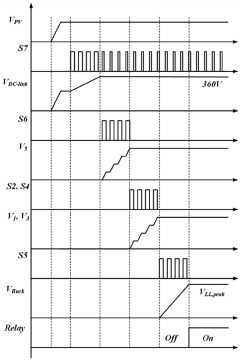Solar Inverter System Design: Best Practices
JUL 17, 20259 MIN READ
Generate Your Research Report Instantly with AI Agent
Patsnap Eureka helps you evaluate technical feasibility & market potential.
Solar Inverter Evolution and Objectives
Solar inverter technology has undergone significant evolution since its inception in the 1990s. Initially designed for simple DC to AC conversion, modern solar inverters have become sophisticated power management systems. The primary objective of solar inverter design is to maximize energy harvest from photovoltaic (PV) panels while ensuring grid stability and compliance with regulatory standards.
The evolution of solar inverters can be traced through several key milestones. Early inverters were primarily focused on basic power conversion, with limited efficiency and functionality. As the solar industry grew, inverters evolved to incorporate Maximum Power Point Tracking (MPPT) algorithms, significantly improving energy yield. The introduction of string inverters in the early 2000s marked a shift towards more efficient and cost-effective systems for larger installations.
In recent years, the focus has shifted towards smart inverters capable of providing grid support functions. These advanced inverters can regulate reactive power, ride through grid disturbances, and communicate with utility systems. The integration of energy storage capabilities has further expanded the role of inverters in renewable energy systems, enabling greater flexibility and reliability.
Current objectives in solar inverter design include improving efficiency, reducing costs, and enhancing grid integration capabilities. Manufacturers are striving to achieve conversion efficiencies exceeding 99%, pushing the boundaries of power electronics technology. Size reduction and increased power density are also key goals, driven by the demand for more compact and lightweight solutions.
Another critical objective is the development of inverters that can adapt to evolving grid codes and standards. As renewable energy penetration increases, grid operators are imposing stricter requirements on inverter performance. This necessitates the design of flexible, software-upgradable inverters that can meet future regulatory demands without hardware modifications.
The integration of advanced monitoring and diagnostic features is becoming increasingly important. Modern inverters are expected to provide detailed performance data, predictive maintenance capabilities, and remote management options. This trend aligns with the broader movement towards smart, connected energy systems.
Looking ahead, the solar inverter industry is poised for further innovation. Research is ongoing in areas such as wide-bandgap semiconductors, which promise higher efficiency and power density. The development of modular, scalable inverter architectures is another area of focus, aiming to provide more flexible solutions for diverse installation types.
The evolution of solar inverters can be traced through several key milestones. Early inverters were primarily focused on basic power conversion, with limited efficiency and functionality. As the solar industry grew, inverters evolved to incorporate Maximum Power Point Tracking (MPPT) algorithms, significantly improving energy yield. The introduction of string inverters in the early 2000s marked a shift towards more efficient and cost-effective systems for larger installations.
In recent years, the focus has shifted towards smart inverters capable of providing grid support functions. These advanced inverters can regulate reactive power, ride through grid disturbances, and communicate with utility systems. The integration of energy storage capabilities has further expanded the role of inverters in renewable energy systems, enabling greater flexibility and reliability.
Current objectives in solar inverter design include improving efficiency, reducing costs, and enhancing grid integration capabilities. Manufacturers are striving to achieve conversion efficiencies exceeding 99%, pushing the boundaries of power electronics technology. Size reduction and increased power density are also key goals, driven by the demand for more compact and lightweight solutions.
Another critical objective is the development of inverters that can adapt to evolving grid codes and standards. As renewable energy penetration increases, grid operators are imposing stricter requirements on inverter performance. This necessitates the design of flexible, software-upgradable inverters that can meet future regulatory demands without hardware modifications.
The integration of advanced monitoring and diagnostic features is becoming increasingly important. Modern inverters are expected to provide detailed performance data, predictive maintenance capabilities, and remote management options. This trend aligns with the broader movement towards smart, connected energy systems.
Looking ahead, the solar inverter industry is poised for further innovation. Research is ongoing in areas such as wide-bandgap semiconductors, which promise higher efficiency and power density. The development of modular, scalable inverter architectures is another area of focus, aiming to provide more flexible solutions for diverse installation types.
Market Demand Analysis for Solar Inverters
The global solar inverter market has experienced significant growth in recent years, driven by the increasing adoption of solar energy systems across residential, commercial, and utility-scale applications. This growth is primarily fueled by the declining costs of solar photovoltaic (PV) systems, government incentives, and a growing awareness of the need for sustainable energy solutions.
In the residential sector, there is a rising demand for solar inverters as homeowners seek to reduce their electricity bills and carbon footprint. The trend towards smart homes and energy management systems has further boosted the market for advanced inverters with monitoring and control capabilities. Commercial and industrial sectors are also showing increased interest in solar inverters, driven by corporate sustainability goals and the potential for long-term cost savings.
The utility-scale segment represents a substantial portion of the solar inverter market, with large-scale solar projects being developed worldwide. This segment demands high-capacity inverters with advanced grid support features to meet stringent utility requirements. The growing trend of solar-plus-storage systems has created a new market opportunity for hybrid inverters that can manage both solar PV and battery systems.
Geographically, Asia-Pacific leads the solar inverter market, with China and India being major contributors due to their ambitious renewable energy targets and supportive policies. Europe follows closely, with countries like Germany, Italy, and Spain driving demand through their well-established solar markets. The North American market, particularly the United States, is also experiencing robust growth, supported by federal and state-level incentives.
The market demand for solar inverters is closely tied to technological advancements. There is a growing preference for string inverters over central inverters in many applications due to their flexibility and improved performance. Additionally, the shift towards higher voltage systems (1500V) is driving demand for inverters capable of handling these higher voltages, particularly in utility-scale projects.
Energy efficiency and power density are key factors influencing market demand. Inverters with higher efficiency ratings and smaller footprints are increasingly sought after, as they contribute to overall system performance and cost-effectiveness. The integration of advanced features such as reactive power control, grid support functions, and remote monitoring capabilities is becoming standard, driven by evolving grid codes and the need for better grid integration of solar power.
As the solar industry continues to mature, there is an increasing focus on reliability and longevity. This has led to a demand for inverters with longer warranties, improved thermal management, and robust design to withstand harsh environmental conditions. The market is also seeing a trend towards modular and scalable inverter solutions, allowing for easier maintenance and future system expansions.
In the residential sector, there is a rising demand for solar inverters as homeowners seek to reduce their electricity bills and carbon footprint. The trend towards smart homes and energy management systems has further boosted the market for advanced inverters with monitoring and control capabilities. Commercial and industrial sectors are also showing increased interest in solar inverters, driven by corporate sustainability goals and the potential for long-term cost savings.
The utility-scale segment represents a substantial portion of the solar inverter market, with large-scale solar projects being developed worldwide. This segment demands high-capacity inverters with advanced grid support features to meet stringent utility requirements. The growing trend of solar-plus-storage systems has created a new market opportunity for hybrid inverters that can manage both solar PV and battery systems.
Geographically, Asia-Pacific leads the solar inverter market, with China and India being major contributors due to their ambitious renewable energy targets and supportive policies. Europe follows closely, with countries like Germany, Italy, and Spain driving demand through their well-established solar markets. The North American market, particularly the United States, is also experiencing robust growth, supported by federal and state-level incentives.
The market demand for solar inverters is closely tied to technological advancements. There is a growing preference for string inverters over central inverters in many applications due to their flexibility and improved performance. Additionally, the shift towards higher voltage systems (1500V) is driving demand for inverters capable of handling these higher voltages, particularly in utility-scale projects.
Energy efficiency and power density are key factors influencing market demand. Inverters with higher efficiency ratings and smaller footprints are increasingly sought after, as they contribute to overall system performance and cost-effectiveness. The integration of advanced features such as reactive power control, grid support functions, and remote monitoring capabilities is becoming standard, driven by evolving grid codes and the need for better grid integration of solar power.
As the solar industry continues to mature, there is an increasing focus on reliability and longevity. This has led to a demand for inverters with longer warranties, improved thermal management, and robust design to withstand harsh environmental conditions. The market is also seeing a trend towards modular and scalable inverter solutions, allowing for easier maintenance and future system expansions.
Current Challenges in Solar Inverter Technology
Solar inverter technology has made significant strides in recent years, yet several challenges persist in the quest for optimal system design and performance. One of the primary hurdles is the need for increased efficiency across a wide range of input voltages and load conditions. As solar panel outputs fluctuate due to varying environmental factors, inverters must adapt swiftly to maintain high conversion rates, a task that becomes increasingly complex as system sizes grow.
Another significant challenge lies in the realm of power quality and grid integration. Modern solar inverters must not only convert DC to AC but also provide advanced grid support functions such as reactive power control, voltage regulation, and fault ride-through capabilities. These requirements are becoming more stringent as the penetration of solar energy in power grids increases, necessitating more sophisticated control algorithms and hardware designs.
Reliability and longevity remain critical concerns in solar inverter technology. The harsh outdoor environments in which these systems often operate, coupled with the need for continuous operation over decades, pose significant engineering challenges. Thermal management, in particular, is a key issue, as high temperatures can dramatically reduce the lifespan of electronic components and impact overall system efficiency.
The push for higher power densities presents another set of challenges. As the industry moves towards more compact and cost-effective designs, engineers must balance the need for smaller form factors with adequate cooling and electromagnetic compatibility. This balancing act is further complicated by the increasing integration of energy storage systems, which adds another layer of complexity to inverter design and control strategies.
Cybersecurity has emerged as a pressing concern in recent years. As solar inverters become more connected and incorporate advanced communication features, they also become potential targets for cyber attacks. Ensuring robust security measures without compromising system performance or increasing costs significantly is a delicate challenge that manufacturers must address.
Lastly, the rapid evolution of solar panel technology, particularly the shift towards higher voltage systems and bifacial modules, requires continuous adaptation of inverter designs. This constant need for innovation puts pressure on manufacturers to develop flexible and future-proof solutions that can accommodate emerging technologies while maintaining backwards compatibility with existing infrastructure.
These challenges collectively drive the need for ongoing research and development in solar inverter technology, pushing the boundaries of efficiency, reliability, and functionality to meet the demands of an increasingly solar-powered future.
Another significant challenge lies in the realm of power quality and grid integration. Modern solar inverters must not only convert DC to AC but also provide advanced grid support functions such as reactive power control, voltage regulation, and fault ride-through capabilities. These requirements are becoming more stringent as the penetration of solar energy in power grids increases, necessitating more sophisticated control algorithms and hardware designs.
Reliability and longevity remain critical concerns in solar inverter technology. The harsh outdoor environments in which these systems often operate, coupled with the need for continuous operation over decades, pose significant engineering challenges. Thermal management, in particular, is a key issue, as high temperatures can dramatically reduce the lifespan of electronic components and impact overall system efficiency.
The push for higher power densities presents another set of challenges. As the industry moves towards more compact and cost-effective designs, engineers must balance the need for smaller form factors with adequate cooling and electromagnetic compatibility. This balancing act is further complicated by the increasing integration of energy storage systems, which adds another layer of complexity to inverter design and control strategies.
Cybersecurity has emerged as a pressing concern in recent years. As solar inverters become more connected and incorporate advanced communication features, they also become potential targets for cyber attacks. Ensuring robust security measures without compromising system performance or increasing costs significantly is a delicate challenge that manufacturers must address.
Lastly, the rapid evolution of solar panel technology, particularly the shift towards higher voltage systems and bifacial modules, requires continuous adaptation of inverter designs. This constant need for innovation puts pressure on manufacturers to develop flexible and future-proof solutions that can accommodate emerging technologies while maintaining backwards compatibility with existing infrastructure.
These challenges collectively drive the need for ongoing research and development in solar inverter technology, pushing the boundaries of efficiency, reliability, and functionality to meet the demands of an increasingly solar-powered future.
Best Practices in Solar Inverter Design
01 Grid-tied solar inverter systems
These systems connect solar panels to the electrical grid, converting DC power from the panels to AC power for home use and grid feed-in. They often include features like maximum power point tracking (MPPT) and anti-islanding protection for safety and efficiency.- Grid-tied solar inverter systems: These systems connect solar panels to the electrical grid, converting DC power from the panels to AC power for home use and grid feed-in. They often include features like maximum power point tracking (MPPT) and anti-islanding protection for safety and efficiency.
- Microinverter technology: Microinverters are attached to individual solar panels, converting DC to AC at the panel level. This approach can increase system efficiency, especially in partial shading conditions, and allows for easier system expansion and monitoring of individual panel performance.
- Energy storage integration: Solar inverter systems with integrated energy storage capabilities allow for better utilization of solar energy. These systems can store excess energy during peak production times and use it during low production periods or grid outages, improving overall system efficiency and reliability.
- Smart grid communication and control: Advanced solar inverter systems incorporate communication and control features for smart grid integration. These systems can respond to grid conditions, adjust power output, and participate in grid stabilization efforts, enhancing overall grid reliability and efficiency.
- Efficiency improvement techniques: Various techniques are employed to improve solar inverter efficiency, including advanced switching technologies, improved thermal management, and optimized control algorithms. These enhancements result in higher energy yield and reduced conversion losses in solar power systems.
02 Microinverter technology
Microinverters are attached to individual solar panels, converting DC to AC at the panel level. This approach can improve system efficiency, especially in partial shading conditions, and allows for easier system expansion and monitoring of individual panel performance.Expand Specific Solutions03 Energy storage integration
Solar inverter systems with integrated energy storage capabilities allow for better utilization of solar energy by storing excess power for use during non-sunlight hours or grid outages. These systems often include smart energy management features to optimize power flow between solar panels, batteries, and the grid.Expand Specific Solutions04 Smart grid communication and control
Advanced solar inverter systems incorporate communication protocols and control mechanisms for integration with smart grids. These features enable remote monitoring, power quality management, and grid support functions like reactive power control and frequency regulation.Expand Specific Solutions05 Efficiency and reliability improvements
Ongoing developments in solar inverter technology focus on improving efficiency, reliability, and lifespan. This includes advancements in power electronics, thermal management, and fault detection systems. Some innovations aim to reduce the size and weight of inverters while increasing their power density.Expand Specific Solutions
Key Players in Solar Inverter Industry
The solar inverter system design market is in a mature growth phase, characterized by intense competition among established players and emerging innovators. The global market size for solar inverters is projected to reach significant figures, driven by increasing solar energy adoption worldwide. Technologically, the field is advancing rapidly, with companies like Delta Electronics, Huawei Digital Power, and SMA Solar Technology leading in innovation. These firms, along with others such as Enphase Energy and Sungrow Power Supply, are pushing boundaries in efficiency, reliability, and smart grid integration. The competitive landscape is diverse, featuring both large conglomerates and specialized solar technology companies, all vying for market share through continuous R&D and strategic partnerships.
Huawei Digital Power Technologies Co Ltd
Technical Solution: Huawei's solar inverter system design focuses on high efficiency and smart integration. Their string inverters utilize advanced multi-level topologies and incorporate AI-driven algorithms for maximum power point tracking (MPPT). Huawei has implemented a unique smart I-V curve diagnosis technology, which can detect and locate faults in PV arrays automatically, significantly reducing maintenance time and costs[4]. Their inverters also feature built-in PID recovery functionality to mitigate potential-induced degradation in solar panels. Huawei's FusionSolar smart PV solution integrates inverters with a cloud-based management platform, enabling real-time monitoring and optimization of solar plant performance[5]. The company has also developed innovative safety features, such as AI-powered arc fault detection circuit interruption (AFCI) for enhanced system protection[6].
Strengths: High efficiency, advanced fault diagnosis capabilities, and seamless integration with smart management platforms. Weaknesses: Potential cybersecurity concerns due to extensive connectivity features, and reliance on proprietary software ecosystems.
SMA Solar Technology AG
Technical Solution: SMA Solar Technology AG has developed advanced solar inverter systems with a focus on efficiency and reliability. Their Sunny Central series for utility-scale applications incorporates innovative features such as intelligent cooling systems and modular designs. SMA's inverters utilize advanced power electronics and control algorithms to maximize energy yield and grid stability. They have implemented a multi-level topology in their inverters, which allows for higher efficiency and lower harmonic distortion[1]. SMA also integrates advanced monitoring and control capabilities, enabling remote diagnostics and predictive maintenance to minimize downtime[2]. Their inverters are designed with robust protection features, including advanced grid management functions to meet evolving grid codes worldwide[3].
Strengths: High efficiency, advanced grid management capabilities, and robust design for reliability. Weaknesses: Higher initial cost compared to some competitors, and potential complexity in installation and maintenance for some models.
Innovative Solar Inverter Technologies
Inverter arrangement for feeding photovoltaically generated power into a public network
PatentWO2009098093A2
Innovation
- The inverter arrangement features a DC-DC converter with a reference potential set by the positive connection of the solar generator to the intermediate circuit capacitor, ensuring all solar cells have a positive potential with respect to ground or low negative potentials, allowing the use of transformerless inverters with choke coils and anti-parallel freewheeling paths to avoid reactive currents and enhance efficiency.
System for solar inverter and operation method thereof
PatentActiveKR1020210024353A
Innovation
- The system includes a bootstrap circuit in the power conversion unit, which can improve efficiency and reduce costs.
- A relay is used to connect the power conversion unit to the grid only when the converter capacitor voltage meets or exceeds the grid voltage, ensuring stable grid connection.
- The power supply unit receives power through the relay when grid-side voltage conditions are met, improving system reliability.
Grid Integration and Stability Considerations
Grid integration and stability considerations are crucial aspects of solar inverter system design, particularly as the penetration of solar energy in power grids continues to increase. The primary challenge lies in maintaining grid stability while accommodating the variable and intermittent nature of solar power generation. To address this, modern solar inverter systems must incorporate advanced features and functionalities.
One key consideration is voltage regulation. Solar inverters must be capable of dynamically adjusting their output to maintain grid voltage within acceptable limits. This is typically achieved through reactive power control, where inverters can absorb or inject reactive power as needed to support grid voltage stability. Advanced inverters also incorporate volt-var control, which automatically adjusts reactive power output based on local voltage conditions.
Frequency regulation is another critical aspect of grid stability. Solar inverters must be able to respond to grid frequency deviations by adjusting their active power output. This capability, known as frequency-watt control, helps maintain the balance between power generation and consumption, thereby supporting grid frequency stability.
Low-voltage ride-through (LVRT) and high-voltage ride-through (HVRT) capabilities are essential for ensuring that solar inverters remain connected to the grid during short-term voltage disturbances. These features prevent widespread disconnection of solar systems during grid faults, which could otherwise lead to cascading failures and grid instability.
Anti-islanding protection is a crucial safety feature that prevents solar inverters from energizing a de-energized section of the grid. This protection mechanism ensures that maintenance personnel can safely work on power lines without the risk of unexpected energization from distributed solar systems.
Advanced communication and control capabilities are becoming increasingly important for grid integration. Smart inverters equipped with communication interfaces allow for remote monitoring and control by grid operators. This enables better coordination between distributed solar resources and the broader power system, facilitating more efficient grid management and stability control.
Power quality is another significant consideration in solar inverter design. Inverters must produce a clean, sinusoidal output with low harmonic distortion to minimize negative impacts on grid power quality. Additionally, they should be capable of operating at various power factors to support grid stability requirements.
As the grid evolves towards a more distributed and renewable-based architecture, solar inverter systems must also be designed with future grid codes in mind. This includes features such as grid-forming capabilities, which allow inverters to establish and maintain grid voltage and frequency in weak or islanded grid conditions.
One key consideration is voltage regulation. Solar inverters must be capable of dynamically adjusting their output to maintain grid voltage within acceptable limits. This is typically achieved through reactive power control, where inverters can absorb or inject reactive power as needed to support grid voltage stability. Advanced inverters also incorporate volt-var control, which automatically adjusts reactive power output based on local voltage conditions.
Frequency regulation is another critical aspect of grid stability. Solar inverters must be able to respond to grid frequency deviations by adjusting their active power output. This capability, known as frequency-watt control, helps maintain the balance between power generation and consumption, thereby supporting grid frequency stability.
Low-voltage ride-through (LVRT) and high-voltage ride-through (HVRT) capabilities are essential for ensuring that solar inverters remain connected to the grid during short-term voltage disturbances. These features prevent widespread disconnection of solar systems during grid faults, which could otherwise lead to cascading failures and grid instability.
Anti-islanding protection is a crucial safety feature that prevents solar inverters from energizing a de-energized section of the grid. This protection mechanism ensures that maintenance personnel can safely work on power lines without the risk of unexpected energization from distributed solar systems.
Advanced communication and control capabilities are becoming increasingly important for grid integration. Smart inverters equipped with communication interfaces allow for remote monitoring and control by grid operators. This enables better coordination between distributed solar resources and the broader power system, facilitating more efficient grid management and stability control.
Power quality is another significant consideration in solar inverter design. Inverters must produce a clean, sinusoidal output with low harmonic distortion to minimize negative impacts on grid power quality. Additionally, they should be capable of operating at various power factors to support grid stability requirements.
As the grid evolves towards a more distributed and renewable-based architecture, solar inverter systems must also be designed with future grid codes in mind. This includes features such as grid-forming capabilities, which allow inverters to establish and maintain grid voltage and frequency in weak or islanded grid conditions.
Environmental Impact and Sustainability Aspects
Solar inverter systems play a crucial role in the transition towards renewable energy, but their environmental impact and sustainability aspects must be carefully considered. The production of solar inverters involves the use of various materials, including metals, plastics, and electronic components, which can have significant environmental implications. Manufacturers are increasingly focusing on sustainable sourcing and production methods to minimize the ecological footprint of these systems.
One of the primary environmental concerns associated with solar inverters is the energy consumption during their manufacturing process. However, this initial energy investment is typically offset within a few years of operation, as the inverters enable the generation of clean, renewable energy. The lifespan of solar inverters, typically ranging from 10 to 20 years, further enhances their sustainability profile by ensuring long-term clean energy production.
The end-of-life management of solar inverters is another critical aspect of their environmental impact. As these systems reach the end of their operational life, proper recycling and disposal methods are essential to prevent electronic waste accumulation. Many manufacturers are implementing take-back programs and designing inverters with recyclability in mind, facilitating the recovery of valuable materials and reducing landfill waste.
In terms of operational sustainability, modern solar inverters are designed to maximize energy efficiency, minimizing losses during the DC to AC conversion process. This efficiency not only improves the overall performance of solar power systems but also reduces the carbon footprint associated with energy production. Additionally, advanced monitoring and control features in solar inverters enable optimal system performance, further enhancing their environmental benefits.
The integration of solar inverters with energy storage systems, such as batteries, presents new opportunities for sustainability. These hybrid systems can improve grid stability, reduce reliance on fossil fuel-based backup power, and enable more efficient use of solar energy. By allowing excess energy to be stored and used during periods of low solar production, these integrated solutions contribute to a more sustainable and resilient energy infrastructure.
As the solar industry continues to grow, the environmental impact of inverter production and deployment is becoming increasingly important. Manufacturers are investing in research and development to create more sustainable inverter designs, using eco-friendly materials and improving energy efficiency. These efforts, combined with advancements in recycling technologies, are helping to minimize the environmental footprint of solar inverter systems throughout their lifecycle.
One of the primary environmental concerns associated with solar inverters is the energy consumption during their manufacturing process. However, this initial energy investment is typically offset within a few years of operation, as the inverters enable the generation of clean, renewable energy. The lifespan of solar inverters, typically ranging from 10 to 20 years, further enhances their sustainability profile by ensuring long-term clean energy production.
The end-of-life management of solar inverters is another critical aspect of their environmental impact. As these systems reach the end of their operational life, proper recycling and disposal methods are essential to prevent electronic waste accumulation. Many manufacturers are implementing take-back programs and designing inverters with recyclability in mind, facilitating the recovery of valuable materials and reducing landfill waste.
In terms of operational sustainability, modern solar inverters are designed to maximize energy efficiency, minimizing losses during the DC to AC conversion process. This efficiency not only improves the overall performance of solar power systems but also reduces the carbon footprint associated with energy production. Additionally, advanced monitoring and control features in solar inverters enable optimal system performance, further enhancing their environmental benefits.
The integration of solar inverters with energy storage systems, such as batteries, presents new opportunities for sustainability. These hybrid systems can improve grid stability, reduce reliance on fossil fuel-based backup power, and enable more efficient use of solar energy. By allowing excess energy to be stored and used during periods of low solar production, these integrated solutions contribute to a more sustainable and resilient energy infrastructure.
As the solar industry continues to grow, the environmental impact of inverter production and deployment is becoming increasingly important. Manufacturers are investing in research and development to create more sustainable inverter designs, using eco-friendly materials and improving energy efficiency. These efforts, combined with advancements in recycling technologies, are helping to minimize the environmental footprint of solar inverter systems throughout their lifecycle.
Unlock deeper insights with Patsnap Eureka Quick Research — get a full tech report to explore trends and direct your research. Try now!
Generate Your Research Report Instantly with AI Agent
Supercharge your innovation with Patsnap Eureka AI Agent Platform!
